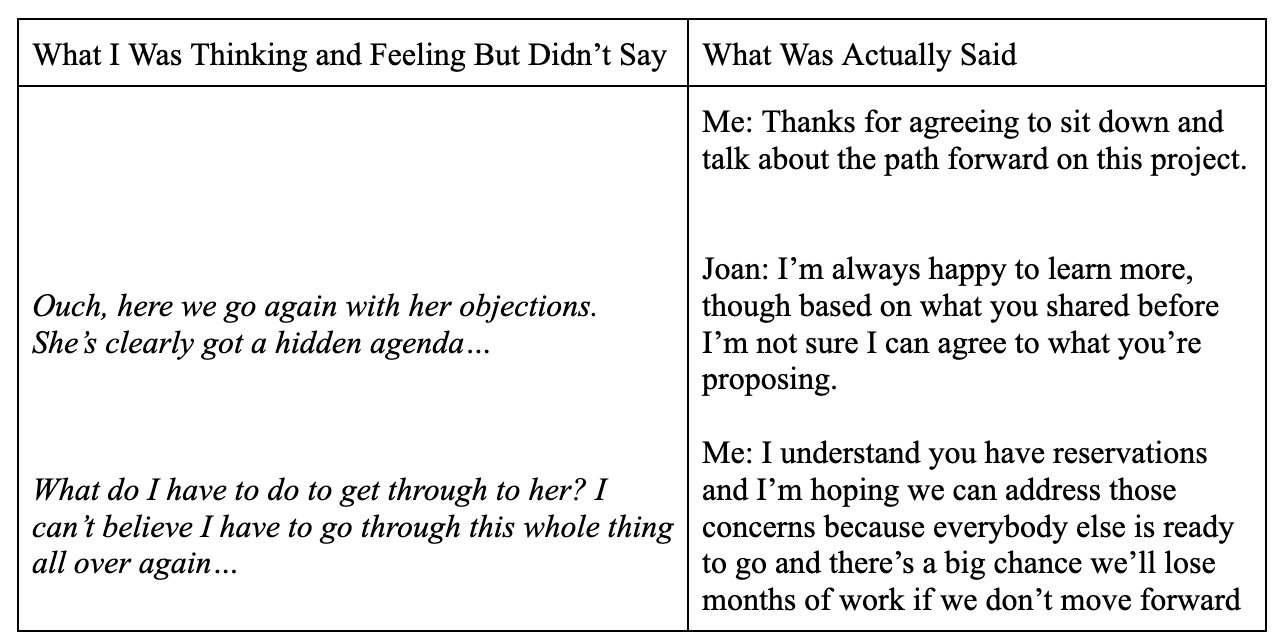5 Tools for High Stakes Communication: Tool #2, Left Hand Column/Right Hand Column
Jun 01, 2022You can learn a great deal by deconstructing problematic conversations after the fact, comparing what was actually said with your unspoken thoughts and feelings. That's what the Left Hand Column/Right Hand column tool is designed for.
This tool was originally developed by Chris Argyris and Donald Schon in their 1974 book Theory in Practice, and popularized by Peter Senge of Harvard Business School in his 1990 bestseller, The Fifth Discipline, as well as Diana McLain Smith, a colleague of both Argyris and Senge. The payoff from this field-building work over the past 50 years is a set of practical skills for communicating more effectively in high stakes situations.
This post is the second in this series, reviewing 5 key tools for communicating effectively in high stakes situations.

Left Hand Column/Right Hand Column: A Simple Technique To Learn and Practice
The technique is simple. Divide a sheet of paper into two columns. In the right hand column, do the best you can to reconstruct a transcript of a significant conversation that did not turn out the way you had hoped. Make it read like a screenplay, with dialogue alternating between the characters. Label this right hand column “What was said.”
Label the left hand column “What I was thinking and feeling but not saying.” Here, add in any unspoken thoughts and feelings across from the corresponding portion of the spoken conversation in the right hand column.
Here’s a quick sample of what this looks like:

An Opportunity for Critical Reflection
The key point of this tool is to give yourself the opportunity to reflect on your own unspoken thoughts and feelings. You don’t want to accept these thoughts and feelings as the “truth”—you want to critically evaluate them instead. Ask yourself for evidence: how do you know that thought is true—can you really be sure? What possibilities would open up if you didn’t believe that thought, or if you chose a different interpretation of the situation. If that were the case, what feelings might you experience instead?
Figuring Out What To Share
With practice, as you develop greater facility understanding and interpreting your thoughts and feelings you can develop a greater ability to productively communicate the key aspects of this inner experience and say them out loud. The idea is not to blurt out everything that’s going on in your left hand column. It could well be that there are ego-driven, ill-considered thoughts and highly reactive, momentary emotions going on inside you. Communicating your entire stream of consciousness to the other person usually doesn’t advance the interaction towards productive collaboration. After all, you don’t have to believe every thought that passes through your own mind or amplify every passing emotion you experience, so you certainly don’t need to ask others to tune into your unexamined inner stream in its entirety.
Instead, sift through that inner stream and identify the helpful thoughts and the processed feelings that can advance mutual understanding with the other person. As you get more practiced with this tool, you may find you are able to sort through your left hand column during the conversation and communicate your “essential unsaids” to the other person in the moment. When you are starting out building this skill, you may find that you need to revisit the conversation at a later time. Either way, when you begin to share more fully and constructively your key thoughts and feelings, you’ve taken a major step forward in effective communication.
Stay connected with news and articles
Join us to receive the latest news and updates from our team.
Don't worry, your information will not be shared, and you can unsubscribe at any time
We hate SPAM. We will never sell your information, for any reason.

